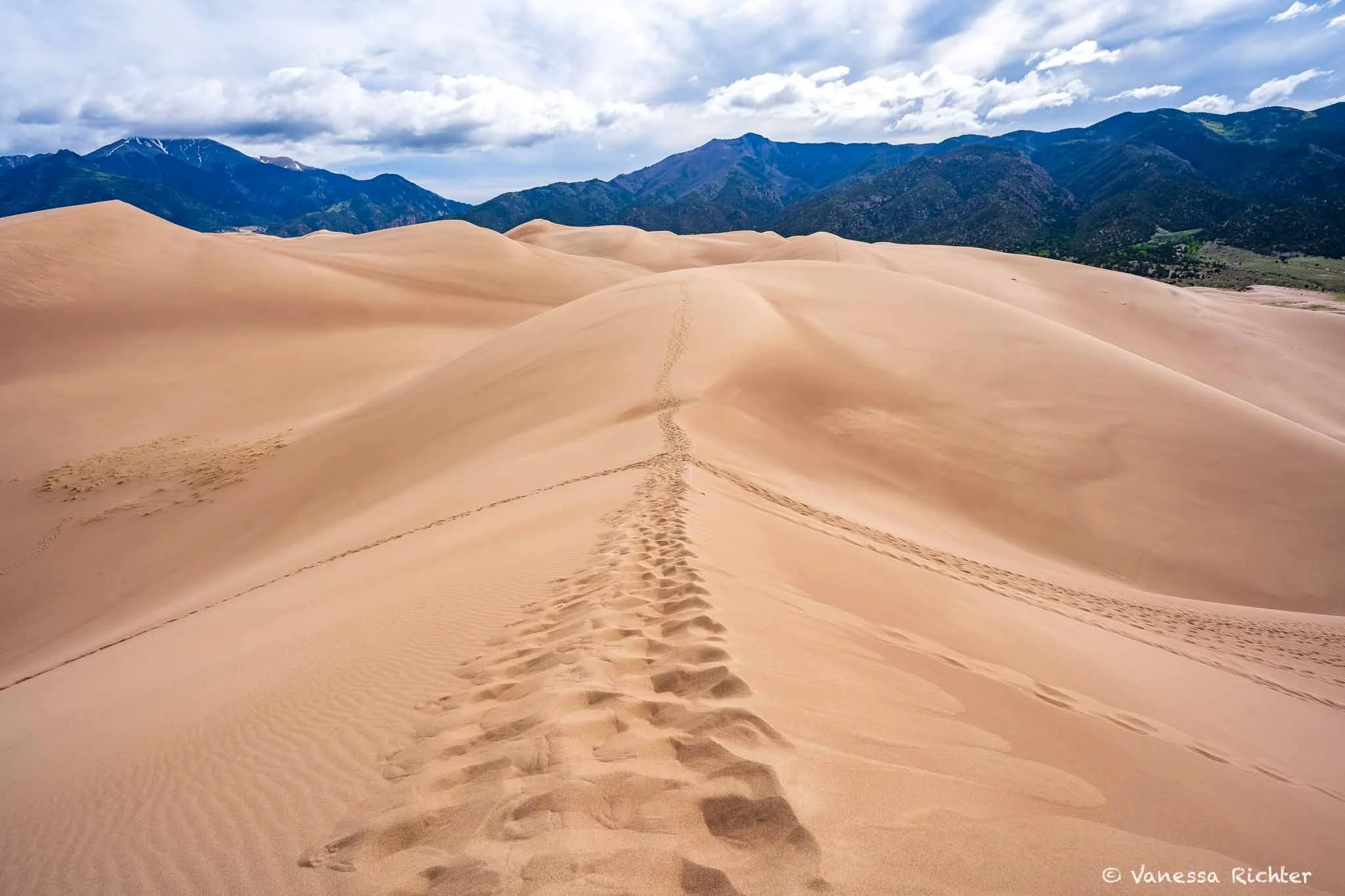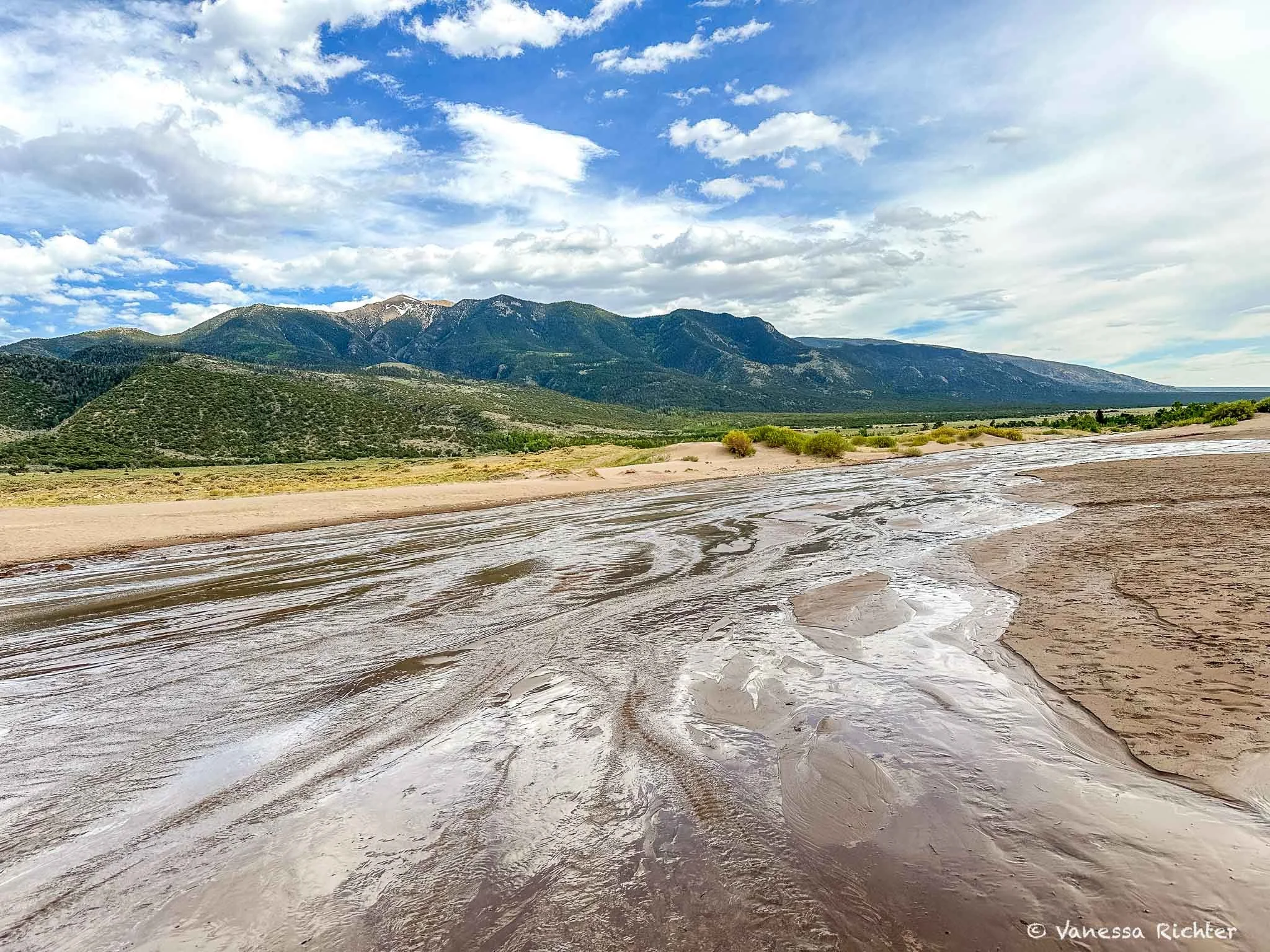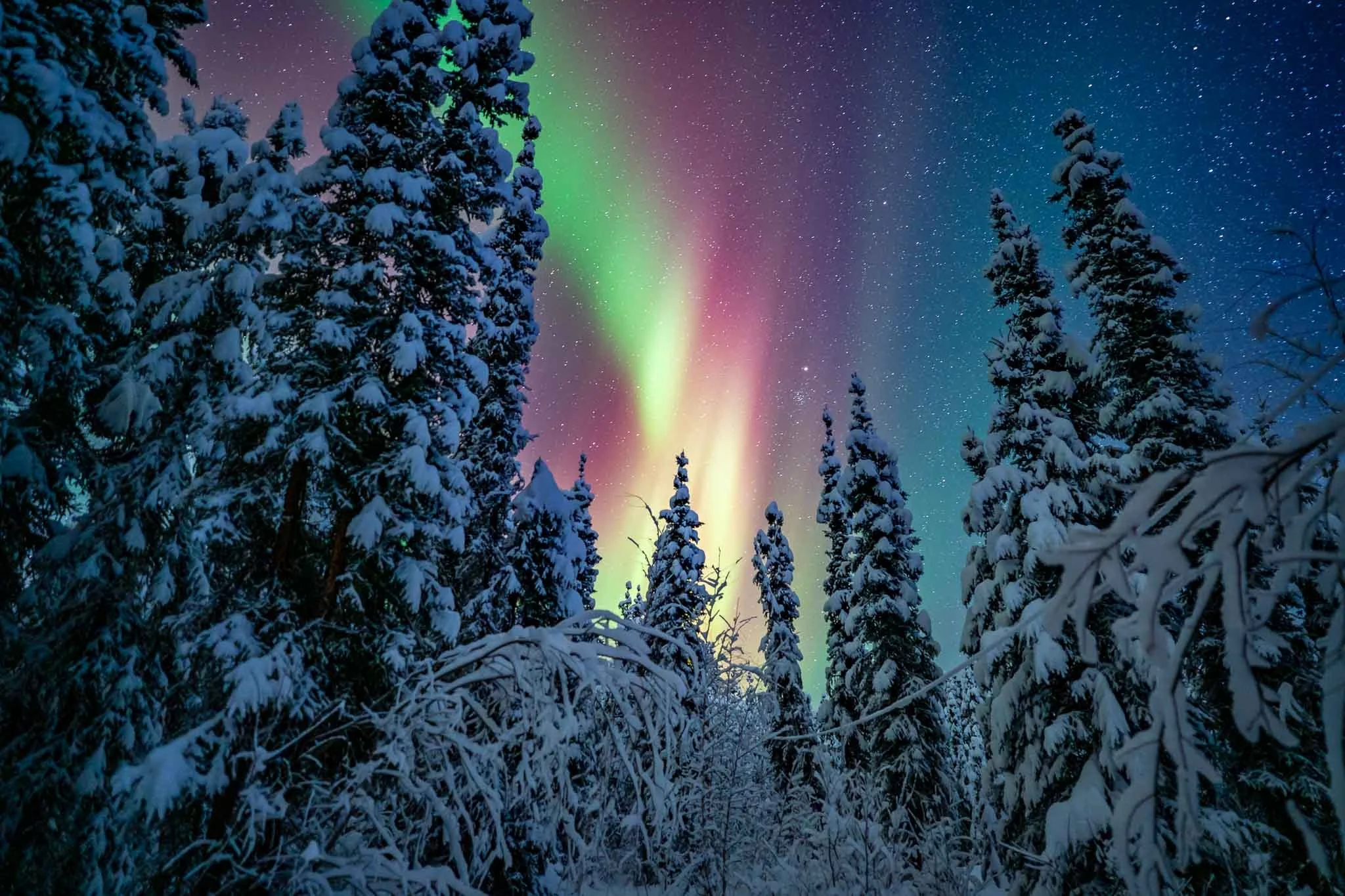High Dune Hike: The Essential Trail at Great Sand Dunes National Park
Great Sand Dunes National Park is one of the most fascinating places on Earth. I know — strong claim — but I truly believe this place is unique in so many ways. How many places do you know where you can gaze at vast dune fields stretching out before you, framed by greenery and scrubs, all at the foot of towering, snow-capped mountain peaks?
The hike to High Dune is the perfect introduction to the vast dunefield at Great Sand Dunes National Park. It strikes the ideal balance between effort and reward, offering breathtaking panoramic views of the rolling sand dunes below and the snow-capped Sangre de Cristo Mountains beyond.
In this article, I’ll take you on a hike into the dunefield, weave in a bit of story time along with some life lessons inspired by the sand, and provide the essentials you need to plan your own visit to Great Sand Dunes National Park — especially this hike.
So settle in, grab a cup of coffee, tea, or whatever helps you get cozy — and let’s get started!
In a Nutshell: Nature at Great Sand Dunes
How Did the Dunes Form?
The dunes formed over thousands of years from sand and sediments that were once part of ancient lakes and rivers in the San Luis Valley. Prevailing southwesterly winds pushed sand toward the Sangre de Cristo Mountains, while seasonal storm winds from the east helped trap it. This unique combination created North America’s tallest dunes, rising up to 750 feet.
Changing Dunes: Dynamic but Enduring
Though the dunes are constantly shifting, their overall shape and position have remained relatively unchanged for at least 138 years. This dynamic system continues to evolve, shaped by wind, water, and time.
Dune Ecology & Surrounding Habitats
- Diverse Habitats: The park includes not just dunes, but also grasslands, shrublands, wetlands, forests, and alpine tundra.
- Water Sources: Seasonal creeks like Medano Creek support wetlands and are essential for amphibians and migratory birds.
- Adapted Species: Several species are endemic to the dunes, meaning they’re found nowhere else on Earth. One example is the Great Sand Dunes tiger beetle.
- Vegetation: Plants like blowout grass and scurfpea help stabilize the sand and support the food web.
Source: National Park Service: Nature & Science at Great Sand Dunes
Story Time: Our Morning Climb to High Dune
Have you ever noticed what happens to phone batteries after a couple of years? They’re fully charged, then you call a friend or take a few pictures, and huh — what was at 100% not long ago is suddenly drained. And you think: What did I even do that sucked out all the energy so freakin’ fast? That can’t be right.
Now, you might be wondering why I’m talking about old phone batteries in a story about the outdoors. Fair enough. But honestly, it’s the best analogy I can think of to describe what it feels like hiking uphill on sand dunes.
You start off feeling full of energy. But then it only takes a few steps on the relentless fluffiness and softness of the sand, and suddenly your calves are on fire. It’s as if some invisible weight has latched onto your legs, and your stamina makes you feel like you’re 100 years old.
That doesn’t sound very appealing, I guess. But is all the effort worth the reward? Let’s rewind to that morning in early June and take it from there…
The tent opened with the familiar zip, and fresh air rushed inside. It felt good to let in the cool morning breeze. Around us, the entire campground was blanketed in silence, with most people still seemingly asleep — just a light snore from a tent here and there carried by the wind.
While crawling back onto the air mattress and joining the snoring chorus was tempting, we had a different plan this morning: hiking up to the very creatively named ‘High Dune’ in the vast dunefield that stretched out below us — a landscape we had been admiring since last night from our campsite. Just some bushes and a bit of elevation separated us from the beige waves of sand.
We got ready quickly and started making our way down to the dunes from the campground. Our footsteps were the only sound, periodically changing with the surface beneath our feet, accompanied by the desert-scented breeze that softly touched our faces. Soon, the hollow sound of walking on asphalt gave way to the crunch of gravel. Then, the gravel turned into sand, and with that, a peaceful silence replaced the crackling of small stones. We removed our shoes, and the soft, cool sand stroked our feet.
We headed farther toward the piled-up dunes, where, at the base, the fluffy grains were drenched in water — a stream was flowing across the entrance to the dunes. A surge of water caused it to rush up in pulses. The stream was wide, but the water level wasn’t very high, just barely covering our feet. Soon, the stream bed would dry up again, once the snow in the Sangre de Cristo Mountains flanking the dunes had fully melted. On this early June morning, though, the melt was still in full swing, and the giants behind us still wore their white caps.
After crossing the seasonal stream, only sand — as far as the eye could see — lay ahead. Like a painting, the sand formed a sea of hills, its curves, shapes, and shadows flowing seamlessly into one another. What looked so innocent from afar turned out to be a grueling climb. Every step felt like one forward and two back, the soft ground sliding beneath our feet and tiring our calves. Uphill distances that normally wouldn’t be worth mentioning suddenly became a challenge. After we made it up the first significant dune, we let ourselves fall into the sand and enjoyed breakfast with a view of the mountains and dunefield. While the peacefulness of sitting in the sand — combined with the mild annoyance of trying to keep tiny sand grains out of our food — is an “activity” I could have kept doing for much longer, I also really wanted to get further up and explore new angles of the dunes. The nonexistent trail led us onward along a narrow ridge — some sections flat, followed by grueling uphills once again.
It was fascinating to see that, even though footsteps disappeared quickly in the sand and there was no clear path, most people seemed to have chosen the same route we did — which turned out to be a smart one. Not many unnecessary downs, which would have meant even more ups. Instead, the route involved mostly climbing, with some flat stretches that gave us a break from the steeper parts. Along the way, our sense of distance gradually adjusted, and we became more attuned to the unique rhythm of hiking on sand.
Every now and then, a fellow hiker would comment on how much more strenuous uphill sand hiking is. And after a mix of climbing, walking flats along the ridge, and more climbing, we finally reached the destination of our hike: a viewpoint high enough above the dunefield to feel fully immersed, with beautiful patterns of dunes below us and the snow-capped mountains and greenery stretching across the horizon. We took in the surreal view for a while — puffy clouds scattered across the blue sky above and warm beige hues beneath our feet. Dunes, mountains, trees, and endless skies as far as the eye could see.
On our way down, other hikers occasionally asked the usual question — had they almost made it, and was it worth it? We could now say with absolute certainty: yes, it’s worth every single step.
There’s also a couple of life lessons associated with that experience, at least in my view:
No matter how small every step seems in the grand scheme of things, it brings you closer to your goal — even if one step forward feels like two steps back. It’s not. It’s progress. And even if the path ahead feels daunting or seems close but isn’t, the only thing that helps is ignoring how small each step seems and just keep going.
The other lesson is that circumstances matter a lot — whether it’s the literal soil beneath your feet, the different backgrounds people have, mental capacity, or all the factors that shape a life in unique ways. Walking the same distance on sand versus asphalt or gravel is a very different experience, and depending on the ground beneath your feet, the same distance will take more or less effort — both literally and figuratively. If someone hasn’t tried to walk on that same ground, there’s no real way to judge how hard that path is.
Hiking High Dune: Trail Details
📍 Distance: 3.0 mi (4.8 km)
⛰ Elevation Gain: 603 ft (184 m)
🔙 Route Type: Out & Back
High Dune stands out—not as the tallest or highest in elevation, but for its breathtaking views, accessibility, and the illusion of towering above the rest when viewed from the main parking lot. Rising about 692 feet (210 m) from base to top, reaching the first ridge rewards with stunning panoramas of the dunefield and the surrounding landscape.
While navigation apps can provide a rough idea of where to walk, there’s no set trail on the dunes. Footprints quickly vanish in the wind. However, the paths most people take serve as good indicators of the most reasonable routes. If you stay at Piñon Flats Campground, you can start the hike directly from your campsite.
There are other hikes to different dunes, but High Dune one hits the sweet spot for effort and views — and honestly, they couldn’t be better. However, if you’d like to extend the hike, you can continue on to Star Dune, the second-tallest dune in North America at about 736 feet (more direct access is via its base along the Medano Creek bed, without hiking to High Dune first, though). Or, for a more remote adventure, consider tackling Hidden Dune, a 741-foot giant, making it the tallest dune in North America.
Know Before You Go
Best Time to Visit
- Spring: Mild temperatures and a seasonal stream (Medano Creek) — perfect for hiking. Medano Creek typically flows from late April through early June, with peak flow occurring in late May.
- Summer: Air temps average in the mid-70s, but the sand can be brutally hot. Thunderstorms are possible in July and August, so plan for early hikes. Expect more crowds.
- Fall: Cooler weather and fewer visitors make this a great time to explore.
- Winter: Quiet, cold, and potentially snowy. A magical time to see dunes dusted in snow!
Tips For Spring, Summer & Fall
- Start Early for Cooler Sand: The sand heats up fast under the sun even when air temperatures are mild — by midday, it can get too hot to walk on barefoot. Heading out early means cooler sand and more comfortable hiking.
- Hiking Barefoot: I personally love hiking barefoot—no shoes full of sand, and it’s nice to feel the soft sand beneath your feet.
Access & Campground
- Best Access: Staying at Piñon Flats Campground offers the most convenient access to the dunes — you can start the hike right from the campground without driving.
- Trail Conditions: Hiking on sand is tough! Even short distances can feel exhausting, and it's definetly a workout for your calves. This 3-mile sandy hike with moderate elevation did feel harder to me than many longer and steeper trails!
Bucket List Ideas
- Camp in the Dunes: With a permit, you can camp out in the dunes — perfect for stargazing and Milky Way photography.
- Night Hike: An unforgettable way to experience the dunes under moonlight. If you’ve done this, I’d love to hear about your experience!
Read On for More Colorado Adventures & a Complete Road Trip Including Great Sand Dunes
Follow the Adventure
Latest on the Blog
Search












Rocky Mountain National Park is a place where rugged peaks, alpine lakes, and endless skies meet. Whether you’re hiking to a glacier-fed lake, trying to spot moose, elk, or bighorn sheep, or just soaking in the crisp mountain air, Rocky Mountain National Park is a dream for outdoor lovers. In this guide, I'll share my tips on how to make the most of a short visit to Rocky Mountain National Park, tailored to a visit in late spring or early summer. This itinerary is ideal if you want to experience a little bit of everything — from iconic hikes to wildlife viewing and scenic drives.